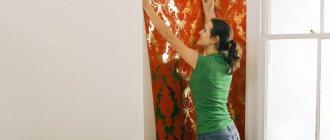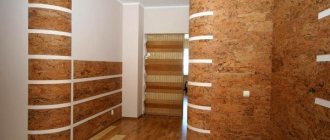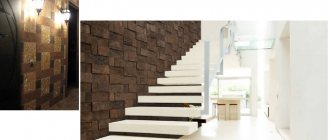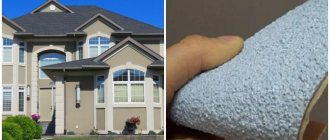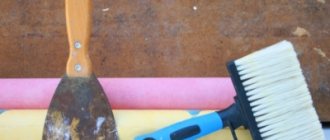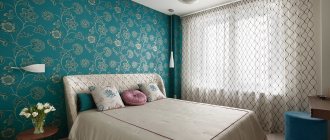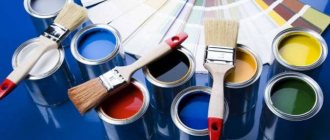Recently, decorating walls with cork has become a very popular way to decorate a room. In order to perform this finishing method, you need to learn how to glue cork to the walls.
Cork coating perfectly absorbs noise and is resistant to all types of deformation.
Decorating walls using cork allows you to get an environmentally friendly coating that will last for quite a long time. Apart from this, there are so many benefits of gluing cork on walls that you need to study before gluing cork on walls.
For example, you can glue cork in a room where there is very high humidity. This fact allows designers to expand their capabilities by creating more stylish and original interiors in various places.
History of cork
Cork coverings came to the world of interior design relatively recently. But already before our era, the versatility and quality of cork oak bark were noticed. Then shoes, barrels, floats, and lids for vessels were made from this material. The corking of wine bottles, according to legend, dates back to the days of a monk named Dom Pérignon, although this is a controversial point, since there is evidence of the use of corks for this purpose by Spanish sailors and the Duke of Bedford in 1665. It was only in the 18th century that the Portuguese were the first to use cork oak bark as a building material, covering their homes with layers of bark from this tree. Their Capuchin monastery is especially famous, the walls and floor of which were already covered with cork.
In Europe, cork began to be actively used for finishing residential premises only at the beginning of the twentieth century. In Russia, it became known only about 15 years ago, and its popularity among other building materials is rapidly growing.
Types of cork wall coverings
Covering walls with cork is not a problem nowadays, you just need to know how to properly glue wall cork, and it is easy to purchase any type of this material. Cork wall coverings can be different:
Wallpaper. Available in two types:
- paper based;
- rolled cork sheet.
Cork wallpaper on a paper base performs a largely decorative function: they have little sound and heat insulation effect due to their small thickness. Pros: they weigh a little, some are already treated with a varnish or wax coating. They can be mounted on both walls and ceilings.
Some cork sheets of this type do not require glue, since they already come with an adhesive composition: you just need to remove the protective film from them and fix it on the wall according to the principle of a self-adhesive film.
Cork roll sheet. More expensive than paper-based wallpaper, as it is denser and thicker. They are sold rolled into rolls; they should not be bent to avoid breakage or cracking. They contain no synthetic substances. Cork in rolls for walls is often sold untreated, so after installation it must be coated with varnish or wax to make it waterproof and more durable. Can be used as a wall covering for a kitchen or bathroom, or combined with other building materials.
Panels, plates, tiles. They are already coated with a protective varnish or wax layer, suitable for wet rooms, and are an excellent insulator of heat and noise.
Cork wall tiles can be single-layer or double-layer. In the latter, the bottom layer is usually painted, and the top layer consists of compressed cork chips (granules, veneer), due to which the colored fragments are visible. This gives the coating an even more original look.
Their installation is perhaps the easiest: even if you need to cover the entire wall, the tiles are simply laid according to the principle of brickwork.
Cork backing. Typically used as an intermediate layer between flooring and laminate. But they are also used for walls, as they perform certain functions:
- has excellent heat and sound insulation;
- serves for additional adhesion of wallpaper to the surface;
- neutralizes wall defects (irregularities, dents, crumbling areas).
Considering the quite pleasant appearance, the question of whether it is possible to glue cork backing to walls exhausts itself. You can mount walls with it, and it will look no worse than with other types of cork coverings. But at the end it is necessary to apply a protective varnish to the surface.
Pros and cons of cork panels
Wall decoration with cork panels is gaining popularity, as the material has excellent technical characteristics and advantages. They are:
- Cork is 100% natural material, does not emit toxic substances and does not harm human health.
- Has the ability to retain heat.
- The panel is soundproof and does not require additional finishing.
- Will not absorb odors. Even after long-term use, no accumulation of aromas is observed.
- They are not afraid of the influence of household chemicals.
- Cork is not afraid of water and can be used in damp areas. But still, prolonged and direct exposure to water is undesirable.
- The surface is matte and non-slip. This is especially true if cork is used as a floor covering.
- Decorative finishing does not rust or rot.
- Fire protection.
- Rot, mold and mildew will not form on the surface, since the cork has anti-condensation properties.
- The material is light and soft, the dent is restored from an impact. If a child falls, there is less risk of injury; walking through traffic has a positive effect on the vertebra.
- The material is antistatic, does not attract dust, and is hypoallergenic.
- Ease of installation work.
- Long service life.
- Durability and reliability.
The finishing also has disadvantages:
- Since the material is natural, its cost is appropriate. Wallpaper or decorative putty will cost less.
- If you use floor panels, the furniture may leave dents on the surface.
- No resistance to abrasives such as sand, wire brush, etc.
- If the room has high humidity, then prolonged exposure to water can lead to swelling of the cork panels.
- Using cork in the interior is not something sophisticated. The decorative qualities of cork are mediocre. But, you can create an ethnic or eco style.
The cork is waterproof. This property allows it to be used to decorate a bathhouse or sauna. It is only important to ensure that moisture does not linger on the surface.
The use of cork coverings in the interior
In addition to walls, cork can be used to install floors, ceilings, and furniture, and it will look no less modern.
Floors. In order to cover the floor with cork, there is no need to remove the previous covering. Linoleum, laminate - all this can be left in place. You can assemble a floating cork floor very quickly, like a puzzle, and if you move, you can assemble it in reverse order and take it with you. Such floors do not absorb dirt, do not collect dust, can withstand heavy furniture, are useful for people with joint diseases, do not cause allergies, and soften sounds (clattering heels, falling objects).
Ceiling. Cork ceilings are moisture-proof and mold-resistant. The same thing is suitable for covering as for walls: rolled wallpaper, tiles. You can cover the entire ceiling, or you can cover it fragmentarily, as your imagination dictates. Before installation, the ceiling surface should be cleaned of the previous coating.
Stages of installing cork walls
Before the covering can be glued, you need to carefully prepare the walls and choose the most suitable adhesive for the cork covering.
Glue selection
Which glue is better to choose depends on many indicators:
- toxicity level;
- setting time;
- reliability and strength.
Not every glue has only positive characteristics, but you still have to make a choice. Therefore, you can see how to glue the cork covering below:
- "Moment". You can glue a cork to a wall using this glue. The glue is universal, durable. Point or linear application is very convenient, especially if tiles are being glued. But there are disadvantages: it can destroy the cork layer or deform it. In addition, Moment is a rather expensive and toxic option. Therefore, if you choose “Moment” glue for cork, then it is better to take a special option - “Moment Cork”.
- "Traffic Moment." An excellent alternative to the usual “Moment”, it is non-toxic, water- and frost-resistant (can be used when covering a glazed balcony), and does not contain toxic solvents.
- "Decol Vern." It is used specifically for cork coverings, a very reliable option. But: highly toxic (you need to work in a respirator), its chemically active composition obliges you to avoid getting the glue on your skin. Flammable. Like Moment, Decol Vern glue sets quickly, so application to the wall must be precise the first time. For the same reason, it is not suitable for wallpaper.
- "PVA". Anyone who has glued cork to PVA knows that this option is not for wallpaper: the glue simply will not withstand their weight. Suitable for tiles, but with the risk of deformation of the cork coating due to the water-based adhesive.
- "Wacol", "Cork House". Great options if you need an odorless glue for cork. Also, these options do not contain solvents, are environmentally friendly, moisture-resistant, and quick-drying.
- Acrylic glue for cork. Used for one-sided gluing, when only the coating is applied.
If a suitable option is not found here, you can consult the construction department on what to glue the cork covering to. In the case of using the substrate as an intermediate layer, it is important to know how to glue the cork to the cork: any suitable glue is used here, but the surface of the substrate must be rough (without varnish).
Preparing the walls
Before pasting, the walls must be cleaned, dry, and leveled. It is also necessary to remove possible mold, damaged previous coating, and fill up crumbling areas. Don't ignore the need for primer.
It is better not to neglect these rules, otherwise the cork on the walls will lie unevenly, and in some places it may come off.
If fragmentary gluing is to be done, you need to mark it on the walls, and also draw a diagram for gluing the tiles.
Since cork is incompatible with gypsum, it is not recommended to cover or putty walls with primers or screeds containing it.
Gluing the coating
When everything is ready, you can proceed directly to pasting. To know how to glue cork to a wall, you need to follow the following rules:
- if the coating is unprotected, be sure to cover it with varnish or wax;
- you can spread either only the cork, or also the wall, and choose the thickness of the adhesive layer according to the instructions;
- after spreading the glue, wait from 15 to 30 minutes (depending on how the glue sets) and apply the material to the wall;
- if you are gluing a tile, start fixing it from the bottom cut, gradually moving upward;
- After gluing, roll the cork with a rubber roller to remove possible air bubbles and irregularities, especially at the joints and corners;
Gluing the cork must be done at a temperature not lower than 18 degrees!
Something in the interior periodically needs to be changed, and sometimes in such cases the question arises: is it possible to glue wallpaper to cork? Yes, but it is better to do this over technical cork, which has a rough surface, or use acrylic primer for a regular coating, and then putty it.
Before pasting, the coating must “get used” to the temperature of the room; to do this, unrolled, it is left to lie in the room where the repair is planned for 24 hours.
It is unlikely that cork coverings will lose their popularity, because their environmental friendliness, versatility, beauty and ease of use are what the modern consumer needs.
Types of material
There is a wide variety of materials available; cork can be differentiated by installation method, physical form, and area of application. Finishing interior walls with cork is available to anyone who wants to update their interior, and it is not necessary to have professional skills.
Cork wallpaper. One of the inexpensive ways to cover a surface with a noble material. The base can be paper or non-woven, on which a cork veneer of small thickness, no more than 0.5 mm, is applied. Some models are equipped with an additional layer of agglomerate, which is present between the base and parts of the veneer. Perfect for renovation in any room. At an attractive price, it has the same aesthetic qualities as slabs, but due to the thin layer, the ability for high thermal insulation and sound insulation is lost. Quite strong and durable material. There are canvases with an adhesive base; they are more expensive, but much more convenient when installing.
Cork panels, tiles or boards. They consist of several layers with a top layer (veneer), agglomerate, a smooth or embossed decorative layer, entirely cork material. Available in tiles up to 5 mm thick. Not afraid of moisture, retain heat perfectly and block increased noise, create a noble appearance. They are convenient for installation, either using glue or having an adhesive element.
